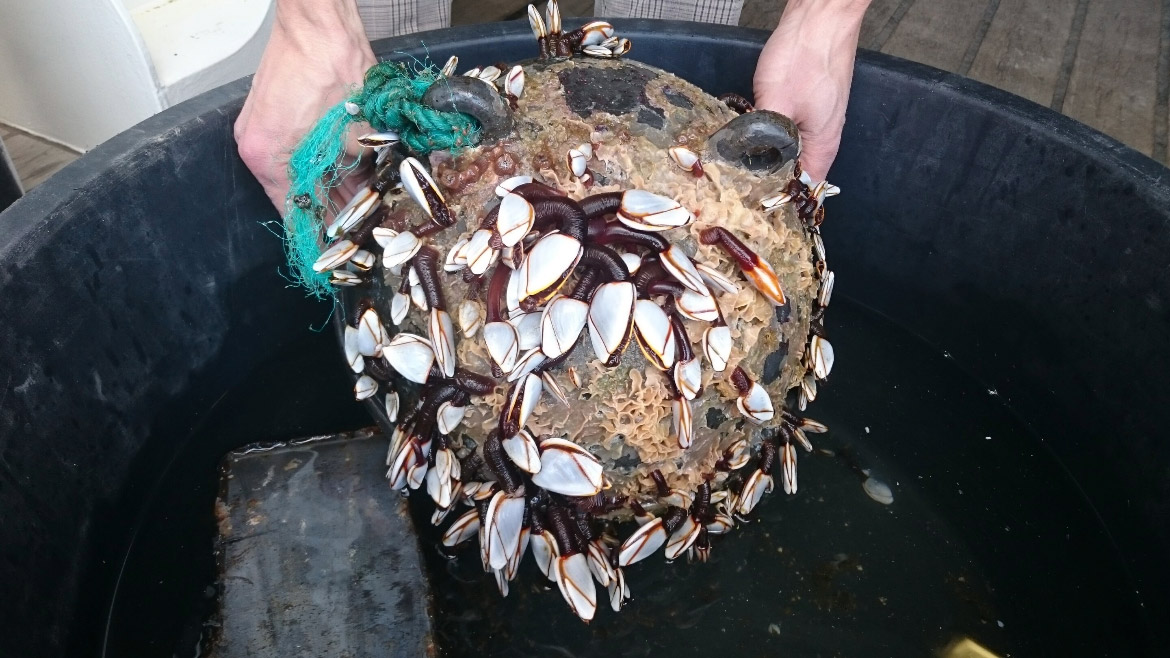Scientists caution against a reliance on mechanical devices to clear water bodies of plastic
Plastic removal technologies are largely untested, and have been shown to harm marine organisms

Ghoose barnacles colonizing an abandoned fishing net float found within the Great Pacific Garbage Patch. Courtesy of Melanie Bergmann, Alfred Wegener Institute
An international group of scientists has cautioned against reliance on mechanical cleanup devices as a means of addressing the plastic pollution crisis.
The researchers—comprising a number of the world's foremost experts in plastic pollution—say they appreciate the clear and pressing need to tackle the millions of tons of waste that have already accumulated in the ocean and waterways.
However, they caution that plastic removal technologies used so far have shown varied efficiency in the amount of waste material they are able to collect, many have not been tested at all.
In fact, some have been shown to harm quantities of marine organisms—including fish, crustaceans and seaweeds—that far exceed the amount of plastic captured, meaning their overall impact on the ocean is potentially more harmful than helpful.
Writing in the journal One Earth, the scientists say with plastic production projected to triple by 2060 the most cost-effective and efficient way to prevent further pollution is to reduce plastic production and consumption, and for essential applications of plastics to design safe, sustainable products with a readily available and effective pathway for end-of-life disposal.
They also assert that the environmental costs of leaving plastic pollution in the ocean should be weighed against the full environmental and economic cost of plastic removal technologies, and call for clear criteria for such judgments to be incorporated in the United Nations Treaty on Plastic Pollution.
Their commentary has been published as world leaders prepare to resume discussions on the Treaty at the third meeting of the Intergovernmental Negotiating Committee on Plastic Pollution.
Lead author Dr. Melanie Bergmann, a marine ecologist at the Alfred Wegener Institute in Germany, said, "So far, we lack hard evidence on the net benefits of plastic removal technologies. On the contrary, there is often bycatch mortality associated with these technologies, which becomes a problem if scaled up. We have to scrutinize these technologies by applying science-based criteria to prevent regrettable outcomes."
The research highlights that in recent years, several forms of cleanup devices have been developed to remove plastics from the environment.
Sieving vehicles are a common sight on tourist beaches, plastic trapping technologies have been deployed in harbors, and various types of booms, watercraft vehicles, bubble curtains, or receptacles have been positioned across rivers and estuaries.
In addition, there are innovations for the open ocean and the seabed that use combinations of towed nets, autonomous vessels and artificial intelligence.
However, the authors of the current paper say that even if these technologies were to show signs of being truly effective, they would barely scratch the surface of the global problem. Cleanup practices could also lead to greenwashing through new "plastic credit" schemes to offset the emissions of plastics through the indiscriminate use of unselective and harmful plastic removal technologies.
As a result, the international group is concerned that focusing too greatly on cleanup approaches will create more environmental risk, and be a distraction from the key priorities of the Plastic Treaty negotiations: Plastic pollution prevention.
More information: Moving from symptom management to upstream plastics prevention: The fallacy of plastic cleanup technology, One Earth (2023). DOI: 10.1016/j.oneear.2023.10.022. www.cell.com/one-earth/fulltex … 2590-3322(23)00497-9



